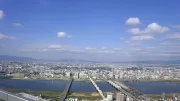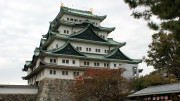Like Tokyo, Osaka has an extensive railway and subway network that makes it easy for tourists to get anywhere they need to go.

As in most Japanese cities, Osaka’s rail network consists of multiple competing companies operating independent lines. The major players in central Osaka’s rail system are JR West and the Osaka Municipal Subway. Additionally, several private railway companies run lines that extend into the outer suburbs and connect to cities as far as Kobe and Nagoya.
JR West operates much of Osaka’s above-ground rail network, with its main line being the Osaka Loop Line, which circles the city centre. JR’s primary hub is Osaka Station, located in the Umeda district. This massive station is connected to or located near several stations operated by competing rail networks. JR also operates the Shinkansen (bullet train) to other parts of Japan. However, unlike in Tokyo, the Shinkansen does not stop at JR’s main Osaka Station but instead departs from Shin-Osaka Station, located just one stop away.
For travel within central Osaka—particularly between the Kita and Minami districts—the most convenient option is the Osaka Municipal Subway. The subway system consists of multiple lines that intersect across the city. With stations located every few blocks in central Osaka, and some stations spanning several blocks themselves, many visitors will find that they rarely need to use anything other than the subway. This is one reason why the Japan Rail Pass may not always be the best value in Osaka, as it only covers JR lines and is not valid on the subway.
Like JR, the subway system is fairly English-friendly, with most signs displayed in both Japanese and English. It also uses a simple coding system: each subway line is assigned a unique colour and letter, while each station is given a number. This system makes navigation much easier—for example, remembering N24 is far simpler than trying to recall Imafuku-Tsurumi Station on the Nagahori Tsurumi-ryokuchi Line.
Beyond the subway and JR, private railway companies operate lines in Osaka’s outer suburbs. If your hotel is near one of these lines, you can easily transfer to another network, as private rail lines always terminate near a major JR or subway station. This is why it’s important to know which rail network you’re using and which one you need to transfer to.
Private railway companies such as Hanshin and Hankyu connect Osaka to nearby cities like Kyoto and Kobe, while Kintetsu provides service to Nara and Nagoya. These private railways offer a cheaper but slower alternative to the JR Shinkansen for travel to these destinations.




